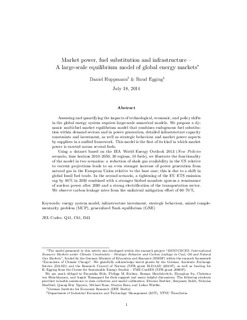Market power, fuel substitution and infrastructure - A large-scale equilibrium model of global energy markets
Journal article, Peer reviewed
Submitted version
Permanent lenke
http://hdl.handle.net/11250/2457745Utgivelsesdato
2014Metadata
Vis full innførselSamlinger
Sammendrag
Assessing and quantifying the impacts of technological, economic, and policy shifts in the global energy system require large-scale numerical models. We propose a dynamic multi-fuel market equilibrium model that combines endogenous fuel substitution within demand sectors and in power generation, detailed infrastructure capacity constraints and investment, as well as strategic behaviour and market power aspects by suppliers in a unified framework. This model is the first of its kind in which market power is exerted across several fuels. Using a data set based on the IEA (International Energy Agency) World Energy Outlook 2013 (New Policies scenario, time horizon 2010–2050, 30 regions, 10 fuels), we illustrate the functionality of the model in two scenarios: a reduction of shale gas availability in the US relative to current projections leads to an even stronger increase of power generation from natural gas in the European Union relative to the base case; this is due to a shift in global fossil fuel trade. In the second scenario, a tightening of the EU ETS emission cap by 80% in 2050 combined with a stronger biofuel mandate spawns a renaissance of nuclear power after 2030 and a strong electrification of the transportation sector. We observe carbon leakage rates from the unilateral mitigation effort of 60–70%.
